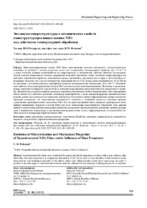| dc.contributor.author | Федосюк, В. М. | |
| dc.coverage.spatial | Минск | ru |
| dc.date.accessioned | 2021-04-08T06:38:57Z | |
| dc.date.available | 2021-04-08T06:38:57Z | |
| dc.date.issued | 2021 | |
| dc.identifier.citation | Федосюк, В. М. Эволюция микроструктуры и механических свойств наноструктурированных пленок NiFe под действием температурной обработки = Evolution of Microstructure and Mechanical Properties of Nanostructured NiFe Films under Influence of Heat Treatment / В. М. Федосюк // Наука и техника. – 2021. – № 2. – С. 109-120. | ru |
| dc.identifier.uri | https://rep.bntu.by/handle/data/90013 | |
| dc.description.abstract | Наноструктурированные пленки NiFe были синтезированы методом импульсного электролитического осаждения на кремнии с золотым подслоем, после чего подвергались температурной обработке при 373–673 К с целью изучения влияния термообработки на микроструктуру и механические свойства объектов исследования. Атомно-силовая микроскопия высокого разрешения позволила проследить этапы эволюции микроструктуры под действием термической обработки, включающие процесс нелинейного увеличения роста зерен и двухстадийную агломерацию. Показано, что с ростом температуры термообработки до 673 К размер зерна увеличивается с 68 до 580 нм по сравнению с исходным образцом, претерпевая процессы агломерации при температурах 100 и 300 °C. Механические свойства наноструктурированных пленок NiFe изучены методом наноиндентирования. Получены и проанализированы зависимости твердости модуля Юнга и значений сопротивления упругопластической деформации от глубины. Данный подход позволил выявить различия в поведении механических свойств поверхностного слоя и внутреннего объема пленки под действием различных температур термообработки, а также продемонстрировать противоположную реакцию разных слоев материала на повышение температуры. В результате анализа деформационных кривых наноиндентирования установлено, что гомогенизация поверхности в сочетании с активацией процессов окисления приводят к упрочнению приповерхностного слоя пленок NiFe. В то же время внутренний объем материала характеризуется нелинейным уменьшением твердости и модуля Юнга при росте температуры термообработки. Объяснение этого явления найдено в комплексном влиянии уменьшения количества межзеренных границ (вследствие увеличения среднего размера зерен с повышением температуры) и увеличения концентрации атомов золота, диффундирующих из подслоя более активно при росте температуры обработки пленок NiFe. | ru |
| dc.language.iso | ru | ru |
| dc.publisher | БНТУ | ru |
| dc.title | Эволюция микроструктуры и механических свойств наноструктурированных пленок NiFe под действием температурной обработки | ru |
| dc.title.alternative | Evolution of Microstructure and Mechanical Properties of Nanostructured NiFe Films under Influence of Heat Treatment | ru |
| dc.type | Article | ru |
| dc.identifier.doi | 10.21122/2227-1031-2021-20-2-109-120 | |
| local.description.annotation | Nanostructured NiFe films were synthesized by pulsed electrolytic deposition on silicon with a gold sublayer, after which they have been subjected to to temperature treatment at 373-673 K in order to study the effect of heat treatment on the microstructure and mechanical properties of the objects under study. High-resolution atomic force microscopy has made it possible to trace the stages of microstructure evolution under the influence of heat treatment, including the process of nonlinear the grain size increases from 68 to 580 nm in comparison with the initial sample, undergoing agglomeration processes at temperatures of 100 and 300 °C. The mechanical properties of nanostructured NiFe films have been studied by the nanoindentation method. The dependences of the hardness of Young’s modulus and the values of the resistance to elastoplastic deformation on depth have been obtained and analyzed in the paper. This approach has permitted to reveal differences in the behavior of the mechanical properties of the surface layer and the internal volume of the film under the action of different heat treatment temperatures, as well as to demonstrate the opposite reaction of different material layers to an increase in temperature. As a result of a thorough analysis of the deformation curves of nanoindentation, it has been found that the homogenization of the surface in combination with the activation of oxidation processes leads to the strengthening of near-surface layer of NiFe films. At the same time, the internal volume of the material is characterized by a nonlinear decrease in hardness and Young’s modulus with an increase in the heat treatment temperature. The explanation for this phenomenon has been found in the complex effect of a decrease in the number of grain boundaries (due to an increase in the average grain size with increasing temperature) and an increase in the concentration of gold atoms diffusing from the sublayer more actively with an increase in the processing temperature of NiFe films. | ru |

